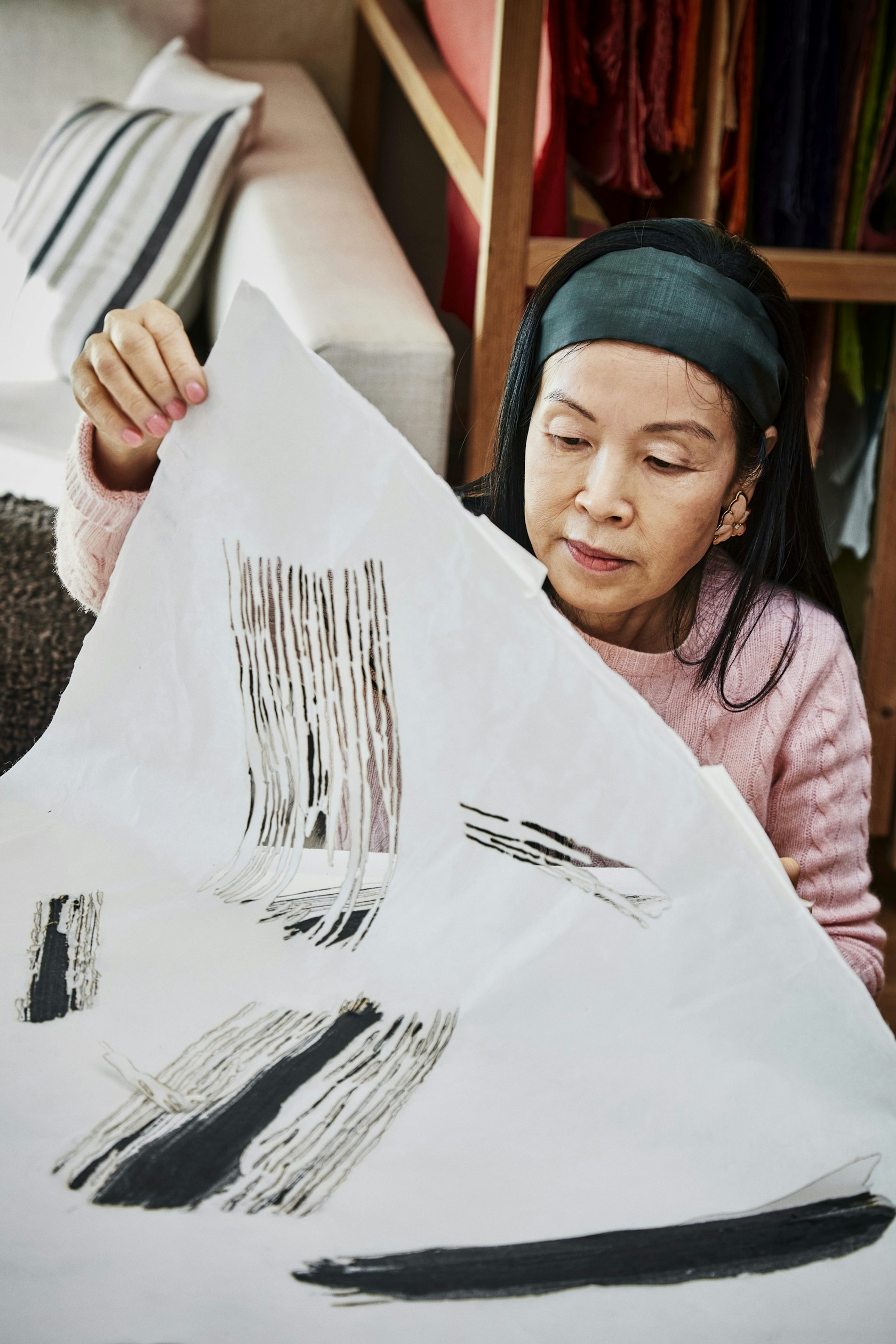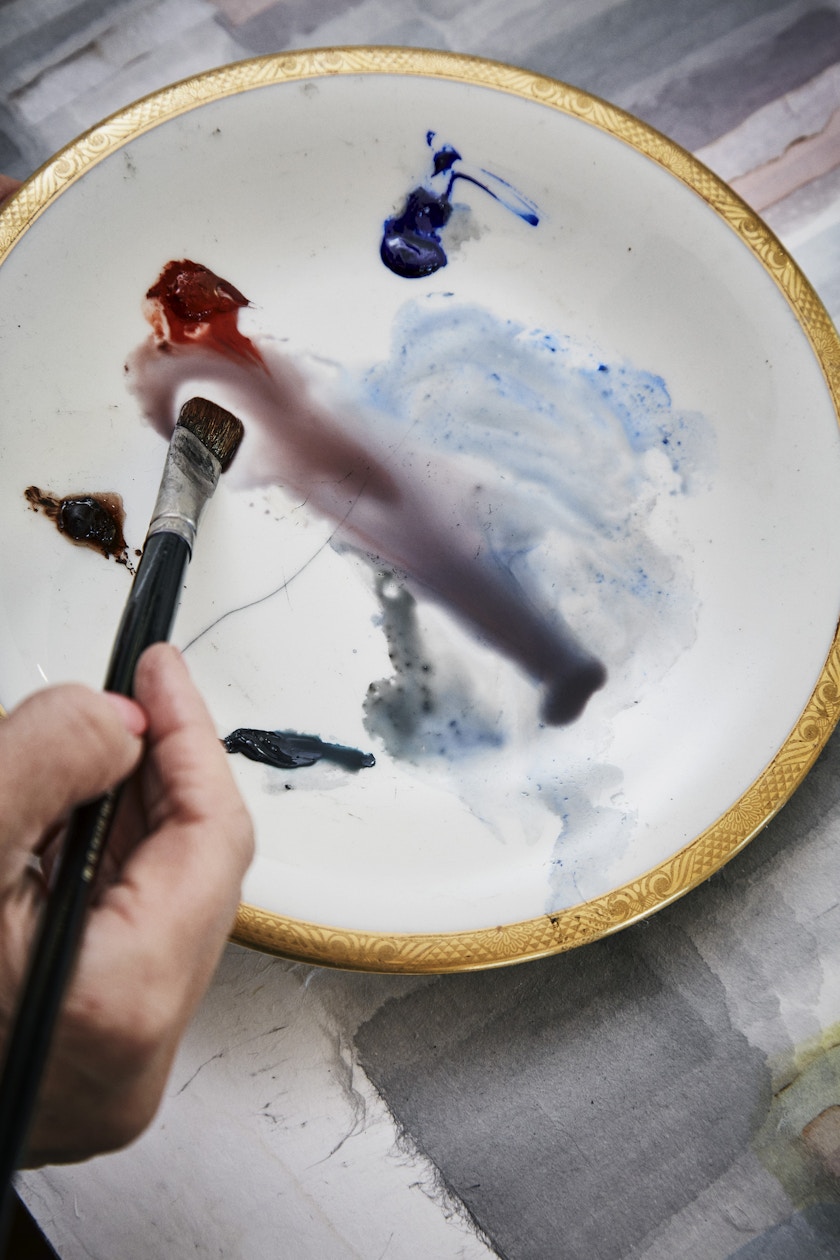
Many layers of burnt paper glued together with starch glue. Photo: Antoine Lippens.
Minjung Kim: Equilibrium, Serenity, Harmony, and Peace
Artist Kim reflects on a life and practice guided by intuition
- By Maria Vogel
- Meet the Artists
Minjung Kim’s essence is her artistry. The resulting material output begins to feel secondary when you grasp Kim’s distinct mode of operating through life and accompanying artistic practice.
In what could be considered a destiny-defining moment, as a young child, Kim gravitated toward the Hanji paper in her father’s print shop in Gwangju, a mountainous metropolitan city in the southwest corner of Korea. Decades and many miles now separate Kim from this foundational time, but what remains is her connection to the material at the center of her practice.
Over time, Hanji became an extension of Kim’s own body, and in her studio space, feeling determines decision-making. Taking in the 61-year-old artist’s œuvre, one could assume that meticulous planning and consideration of form preclude putting material to surface. Quite the opposite approach, Kim says that when she is creating “it’s all play.” She foregoes any sort of narrative premise and leans in to simply understanding the material and its reactive qualities.

Minjung Kim in her studio. Photo: Antoine Lippens.
To Kim, being an artist has been the driving force of her life, her reason to continue forward, a means of survival. The chapters of her life—from childhood, early adulthood, to now—have looked and felt very unalike, but what has endured is her perseverance with the alluring paper she discovered long ago.
At an age when most might be settling into a slower phase of life, Kim is just coming into her own, both personally and professionally. In the past few years, following decades of steady ascent, she has been the subject of major institutional exhibitions and significant market attention. Institutionally, Kim’s work has been exhibited at the Hill Art Foundation, Gwangju Museum of Art, the Langen Foundation, and at Palazzo Caboto during the Venice Biennale in 2015. In November 2024, her work will be shown during a solo exhibition at Fondation Maeght in Saint-Paul de Vence.
Here, Kim reflects on the paths that brought her to today, her kinship with materials, and guiding philosophies that continue to propel her practice forward.

Minjung Kim burning holes with an incense stick, in preparation of the New York series. Photo: Antoine Lippens.
Rather than seeking out your practice, it seems as though your practice found you, through the particular circumstances of your upbringing. Do you feel that you were fated to become an artist?
Recently, on my 60th birthday, I was looking back on my whole life, and I finally felt that I was fated to be an artist. It took me 60 years to truly understand and recognize this aspect of myself.
In your studio, we spoke about how common it can be for artists to feel they should look for external narratives to define their work. You go against this idea, leaning into an internal, indescribable feeling that drives what you create. Has this feeling changed throughout your life or are you always following a similar feeling in your work?
In the midst of both depressive and joyful moments in my career, a weariness with life overcame me. I began questioning my existence, contemplating the essence of why I am in this world. Striving to comprehend myself, I realized that, like an entire cosmos, each individual harbors depths within.
I discovered the more I knew myself (while acknowledging that one may never fully know oneself), my identity became a practice of my art. My art is a consolation of daily life, providing me with a reason to be. I have always wondered about my profession’s contribution to the world. Perhaps, by practicing my inner peace through artistic expression, I could offer the world a small sense of calmness. I figured this could be my reason for being in the world, and ultimately, my humbled reason for being an artist.

Kim’s studio with her work The Street (2023) on display. Photo: Antoine Lippens.
Though you haven’t lived in Korea since the 1990s, your practice is inherently linked to the country through the materiality and the mark-making traditions that you employ. Do you see your work as existing within a certain canon of art?
I always bear in mind that art finds its expression through materials. I chose paper simply because I have been playing with this material since I was four years old. I believe that an artist has to play, and when we are joyfully playing, we transcend ourselves, leaving behind our suffering and our conscience. When we lose our conscience, we can return to a state of purity reminiscent of our childhood self, where we knew nothing but understood everything. This is the status I want to maintain throughout my life and in my practice.
I have never thought about which canon I would be involved with or be described by, nor have I thought about grouping practices. Surely, my art should belong to my own time.

Details from Kim’s studio. Photo: Antoine Lippens.

Your work has a sense of honoring tradition and the past while also existing within a contemporary landscape. Do you feel this duality within your work and is it something you are actively working to balance?
Yes, my practice naturally became a kind of duality. It is a combination of Hanji paper (crafted in Korea) and my experience of more than 30 years in Western culture. Anything I express on top of the paper is a reflection of tradition and the cultures I have experienced in my life to date. Since I have been using these materials throughout all my life, I naturally honor them.
The Hanji paper is crafted by masters. They give all their breath and physical power to create it, utilizing the amazing quality of the mulberry trees. For me, it feels as though someone has already created incredibly beautiful minimal art, and I am adding my action to fill up someone’s immense efforts. It also feels as though I am not creating on my own but more so collaborating with the existing, invisible, and unknown people’s efforts, serving their tradition.

Phasing series process. The first layer involves ink brushes to create free strokes; a second layer is burnt following out the ink stroke. Photo: Antoine Lippens.
You split your time between studios in New York City and the South of France. Does your practice change when you are working in either location? What do you love about each home?
New York City and the South of France have very different atmospheres, philosophies, and attitudes of people toward life. When I practice my art, I enter into my space where my spirit and my feelings are fields in the air. This remains the same wherever I am, as when I am in my working space the outside world doesn’t interfere with my thoughts.
I cherish the South of France for its light, its peace, and its deep-rooted traditions. French culture is really at the service of its own tradition, resisting change in spirits and circumstances. Whenever I come to New York, everything changes within one to two years. There are new buildings, new people, new businesses, it is so fast paced. I love both places so much that wherever I am, I don’t miss the other place. I enjoy the duality and the balance of these fast and slow-paced lifestyles.
Who was an early artistic inspiration to you and why? Who is a current artistic inspiration to you?
When I was very young, I was deeply in love with Botticelli, Leonardo da Vinci, and Raphael. When I started as an art school student in Korea, I began to look at modernist artists such as Paul Klee, Kandinsky, and Calder. After that, I became attracted to American Abstraction and the work of Robert Motherwell, Franz Kline, and Carl Andre—the masters of the 1950s and ’60s. When I moved to Italy, I was hugely inspired by Lucio Fontana and Alberto Burri. And currently, I look up to Vija Celmin, Agnes Martin, and Ruth Asawa.

Details from Kim’s studio. Photo: Antoine Lippens.

If you could describe what you are hoping to achieve through your work in one or a few words, what would it be?
Equilibrium, serenity, harmony, and peace.
What is one thing you are excited by in the studio?
I usually never know what I will do before grabbing my paper, ink, or my brushes, but I am excited to look at the ginkgo tree, as seen through the window. It has beautiful vivid yellow-colored leaves, which I am sure will fill my mind with beautiful color chapters. The practice of an artist is filled with mystery, and I don’t know until I pick up the brush where it will take me. I don’t want to plan, and there isn’t anything I want to do. I want it to come naturally. Without wishes and expectations, my art becomes more serene.
If you could share one piece of advice with an artist of the emerging generation, what would it be?
Don’t force yourself too much to create art. Live faithfully and serve your life. Please your soul—then something will come from within.
Minjung Kim is represented by TEFAF exhibitors Patrick Heide Contemporary Art and Almine Rech.


